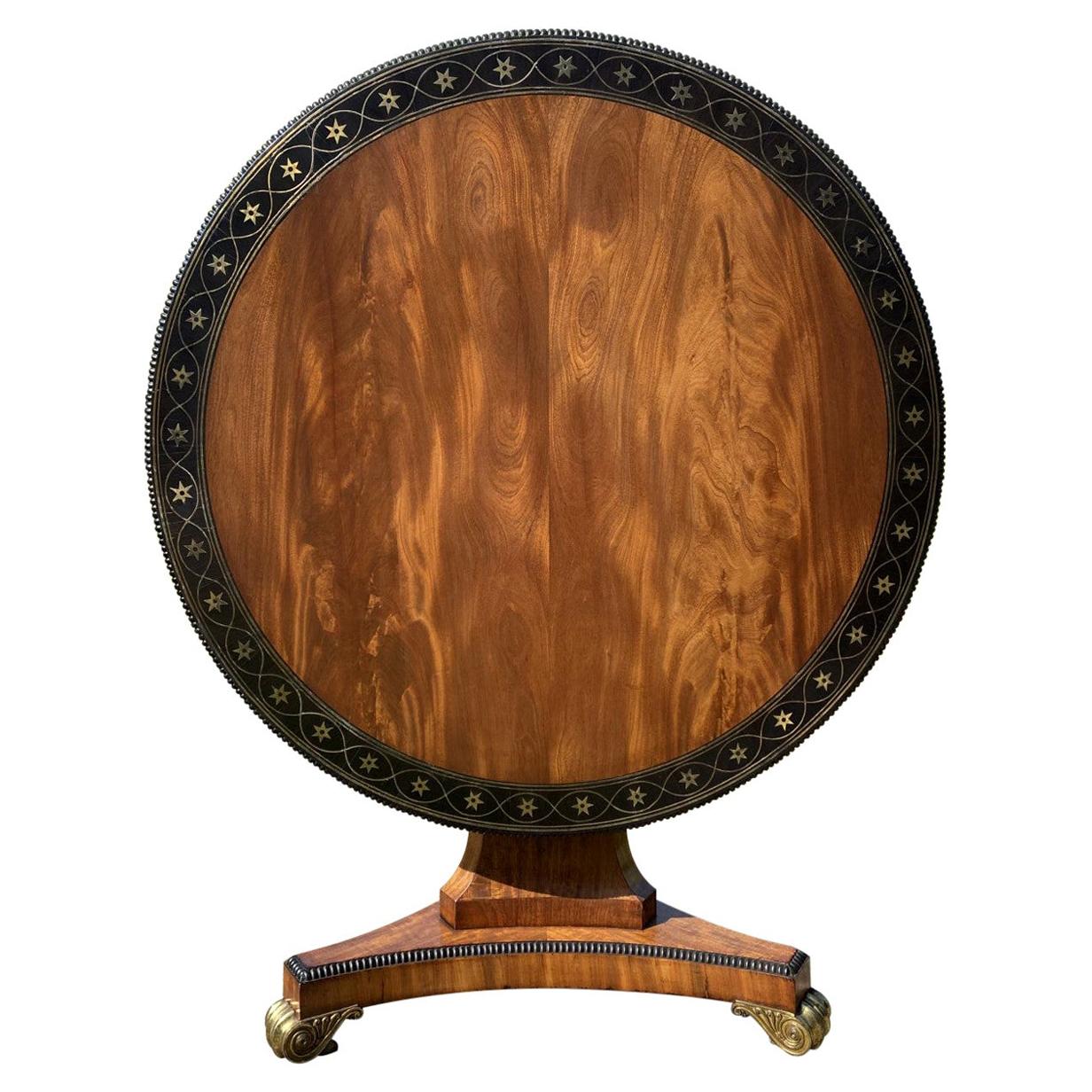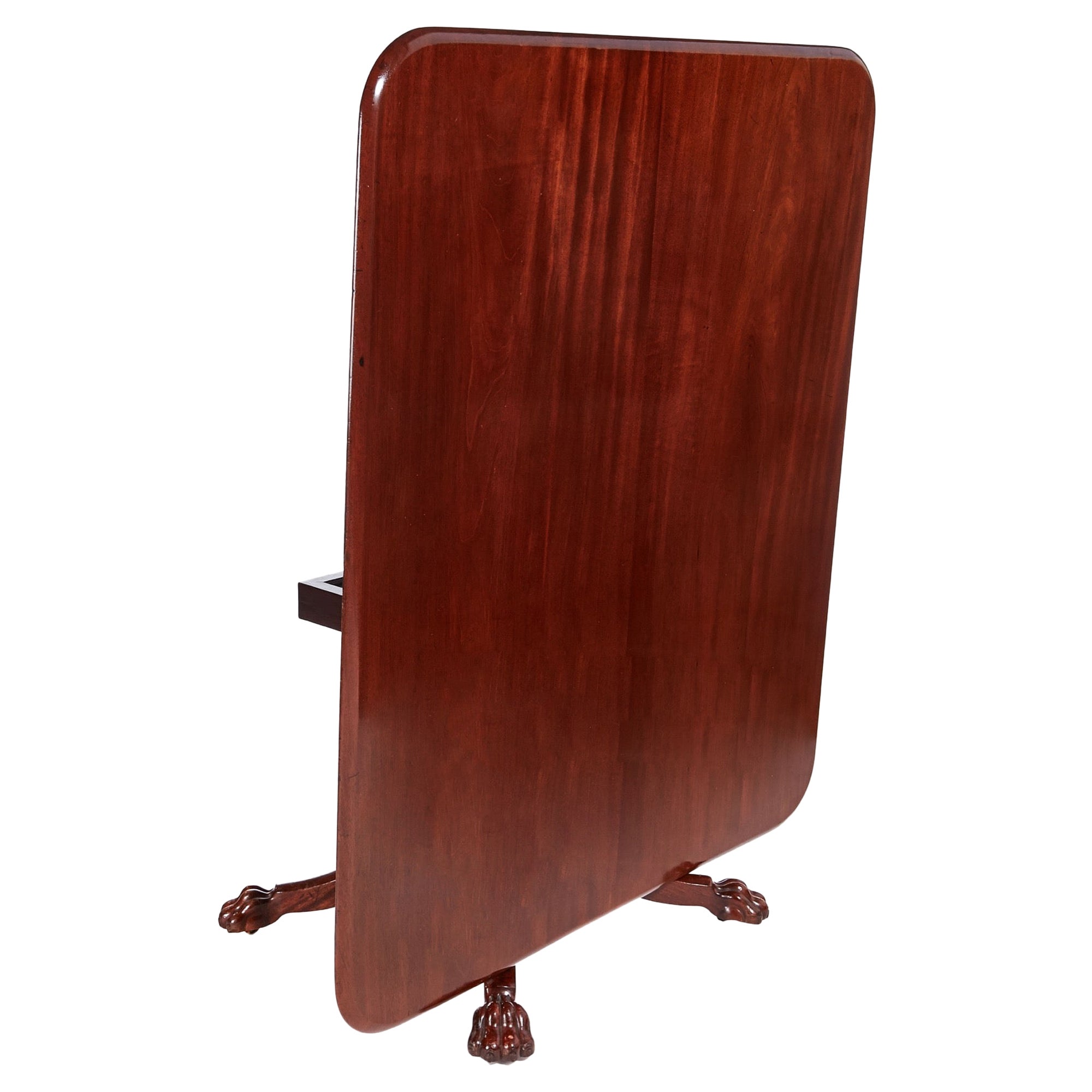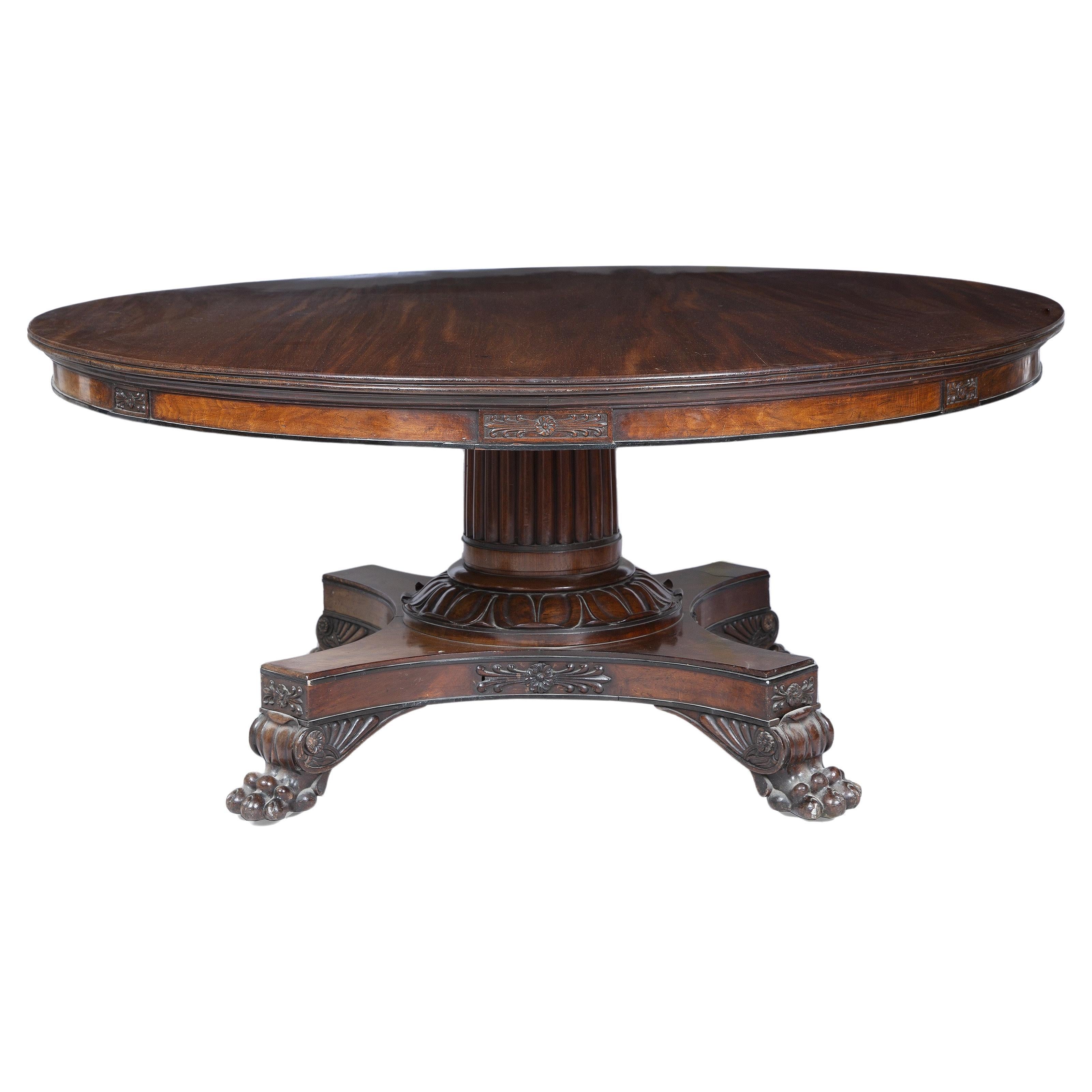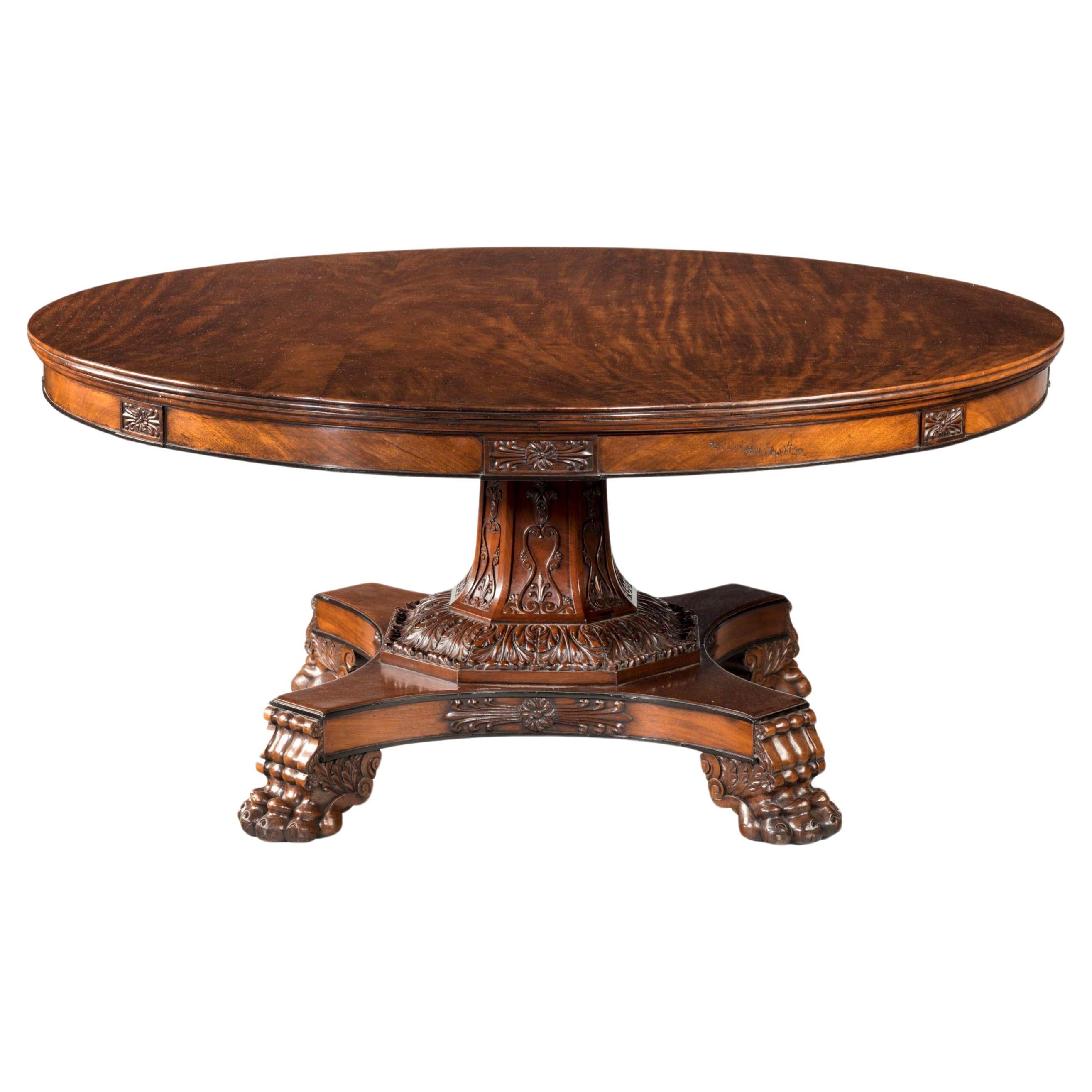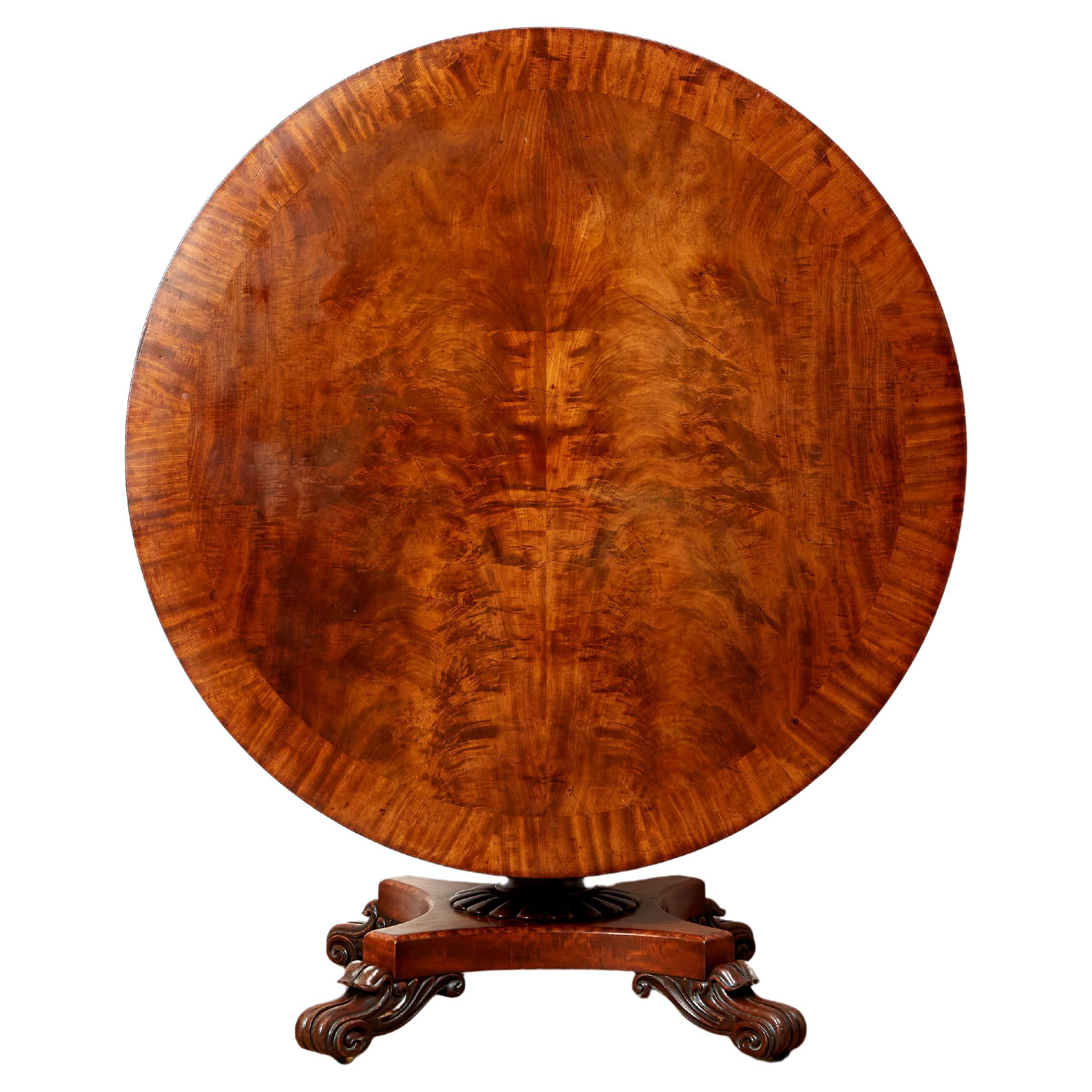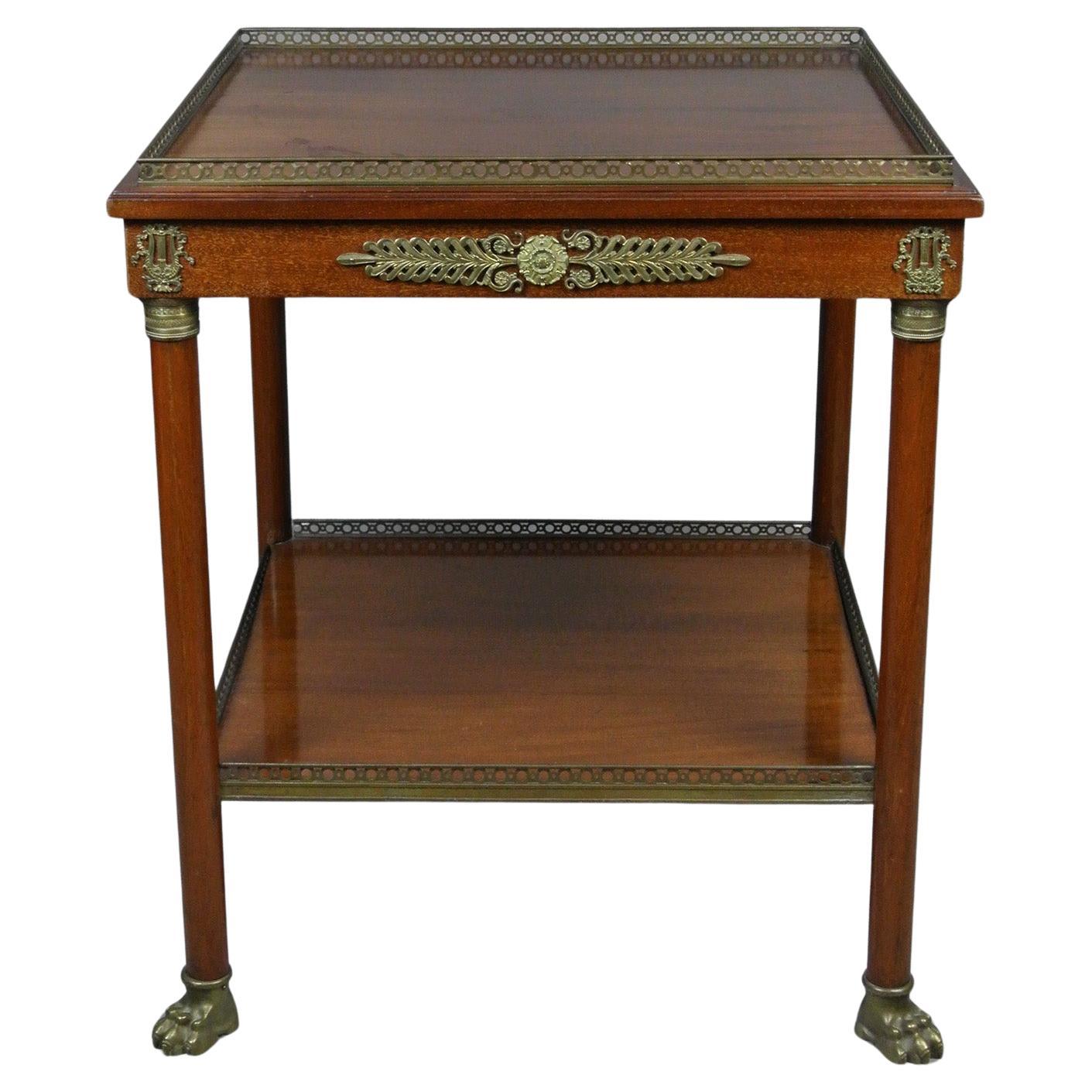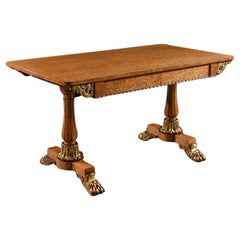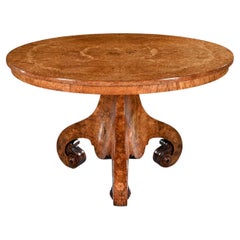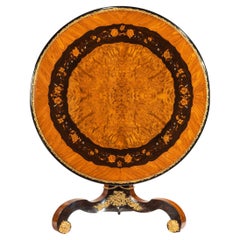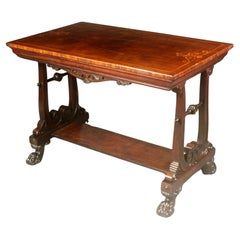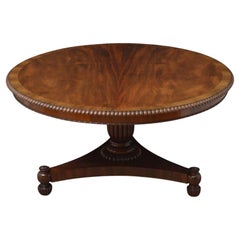
Fine Regency Mahogany Centre Table, Possibly a Unique Commission Based on the De
View Similar Items
Want more images or videos?
Request additional images or videos from the seller
1 of 7
Fine Regency Mahogany Centre Table, Possibly a Unique Commission Based on the De
About the Item
- Dimensions:Height: 29.25 in (74.3 cm)Diameter: 51.25 in (130.18 cm)
- Style:Regency (Of the Period)
- Materials and Techniques:
- Place of Origin:
- Period:
- Date of Manufacture:Circa 1825
- Condition:Wear consistent with age and use.
- Seller Location:Benington, GB
- Reference Number:Seller: 29471stDibs: LU1183236142612
About the Seller
5.0
Vetted Seller
These experienced sellers undergo a comprehensive evaluation by our team of in-house experts.
Established in 1969
1stDibs seller since 2015
112 sales on 1stDibs
Typical response time: 1 hour
Associations
LAPADA - The Association of Arts & Antiques DealersThe British Antique Dealers' Association
More From This SellerView All
- Fine William Iv Birdseye Maple and Carver Giltwood Library or Centre TableLocated in Benington, HertsAn Elegant William IV Birdseye Maple and Carver Giltwood Library / Centre or Sofa Table English Circa 1830 This distinctive library or centre table of birdseye maple and carved g...Category
Antique 1830s English William IV Center Tables
MaterialsBirdseye Maple
- Fine Burl Amboyna and Marquetry Centre Table Attributed to George Blake and Co aBy George Blake & Co.Located in Benington, HertsA Fine Burl Amboyna and Marquetry Centre Table Attributed to George Blake and Co and Probably Retailed by Edward Holmes Baldock English London made Circa 1845. An exceptional table of wonderful colour, utilising the finest amboyna veneers as a background for a complex pattern of floral marquetry on the stem, feet and table top. The tilt-top with segmented veneers and central floral inlay within an inlaid floral scroll surround and with a conforming inlaid outer border. The triform pedestal base with foliate inlay, carved leaf scroll feet with carved lateral flower head roundels with recessed castors. The basic design for this table comes from the work of the designer Richard Bridgens and was published in 1838 as plate 16 in his Furniture with Candelabra. As can be seen from the image of Bridgens' design, the outer scrolling border on the top of our table is very much in the style of that suggested in the design but the other marquetry is of a sophisticated floral type popularised slightly later, suggesting a date of c.1845 for our table. Marquetry of this sort was a speciality of the Blake family, marquetry experts and associates of the great dealer Edward Holmes Baldock. Baldock was responsible for building some museum quality collections of fine 18th century French furniture during this period for some of his famous aristocratic clients but he also supplied new furniture in the French taste, often incorporating marquetry by the Blake firm. The use of exotic amboyna as the ground for this marquetry is also in keeping with other pieces known to have been supplied by Baldock, for whom it appears only the best was good enough. The sinuous lines of this table and the exotic veneers give the piece a more timeless feel than many other examples from this period and the colour means that it would work equally well in a contemporary interior or alongside pieces of Art Deco furniture as it would in a more traditional room. This is a piece of sublime quality that somehow manages to be both decorative and yet understated and as such is exactly the sort of piece we enjoy sharing with our clients. Edward Holmes Baldock (1777-1845) Born on the 14th May 1777 he established his business in 1805 in Hanway Street which over the years he expanded at this location. He soon was a prominent London furniture dealer to several members of the Royal Family and is responsible for supplying French-fashioned furniture to the 5th Duke of Buccleuch. Edwards Holmes Baldock’s pieces have become a prized possession amongst collectors, museums and dealers alike. The use of a variety of specimen woods can often been seen on attributed and signed tables by Edward Holmes Baldock, reminiscent of those on the present table. Baldock was thought to have worked very closely to with the master of marquetry and inlay of the 19th Century Robert Blake who had workshops adjacent to Baldock’s retail premises. Pieces in public collections with likely links to the Blake Family include a piano in the Metropolitan Museum of Art, a writing desk in Goodwood House, a centre table in Syon House, a circular table in Alnwick Castle, an octagonal table in the Leeds City Art Gallery at Temple Newsam House and also signed works in the Victoria and Albert Museum. Baldock's works often imitated the important pieces of 18th-century French furniture that Francophile collectors including George, Prince of Wales, later George IV, William Beckford, Francis Seymour Conway, 3rd Marquess of Hertford and George Watson...Category
Antique 1840s European Center Tables
MaterialsBurl, Amboyna
- Exceptional 19th Century Marquetry Centre Table, Edward Holmes BaldockBy Edward Holmes BaldockLocated in Benington, HertsAn exceptional marquetry and ormolu centre table of exhibition quality attributed to Edward Holmes Baldock. English, circa 1840. Finely co...Category
Antique Mid-19th Century British Early Victorian Center Tables
MaterialsEbony, Maple, Tulipwood
- Rare 19th Century Peters of Genoa Satinwood & Rosewood Centre TableBy Henry Thomas PetersLocated in Benington, HertsA rare and finely constructed circular satinwood centre table most probably by Henry Thomas Peters of Genoa. Italy Circa 1830. The circular tilt top having a finely chosen cuts of book-matched West Indian satinwood veneer with a rosewood banded and moulded edge over a splayed in-curved quatroform base, terminating on four acanthus carved scrolled rosewood lions paw feet raised on brass castors. A very fine table with wide cuts of satinwood which would have been extremely expensive in the early 19th Century. Inspired by the French Empire design as viewed through the lens of English Regency, in particular the designs of Thomas Hope of 1807, along with the construction all point to Henry Thomas Peters being the maker, active in Genova around 1820 to 1850, being one of the leading cabinet makers of the period obtaining the title of ‘cabinetmaker of his Majesty’. Henry Thomas Peters’ English antecedents remain obscure although he probably began his career in England. However, he is not listed in Beard and Gilbert’s Dictionary of English Furniture Makers 1660-1840. He arrived in Genoa in circa 1817, and by 1824 had established a workshop in Via Balbi, a neighbourhood in which the Royal Palace and other noble residences were located; today some of his works are preserved in the Palazzo Rosso, Genoa and were probably bequests from the various aristocratic families for whom he worked, including the Brignole Sale family. Peters was appointed by the Court of Savoy and produced furniture for their palaces in Turin, Genoa and Racconigi including the Palazzo Reale. Notably, in 1841, furniture for the wedding of Prince Vittorio Emanuele. In 1846, Peters and his extensive workshop won the silver medal at the Esposizione dei Prodotti e delle Manifatture Nazionali. As pointed out Peters was famed for producing furniture with the technical accuracy typical of English but adapted to the late Italian Empire style. A set of six Italian Giltwood...Category
Antique 19th Century Italian Center Tables
MaterialsRosewood, Satinwood
- Outstanding Italian Carved Wood Polychrome Centre Table with Onyx Top by AmuletLocated in Benington, HertsA one off masterpiece by Amulet Berton (1875 - 1967). Italian carved wood faux bois vine branch polychrome centre table parcel gilt with onyx top in the Venetian style. Italy ...Category
20th Century Italian Center Tables
MaterialsOnyx
- Important Regency Mahogany Partners Writing Table in the Manner of George SmithBy George Smith, Charles NormanLocated in Benington, HertsA highly Important, Early Regency period mahogany, ebonised and parcel-gilt partners writing table on monopodia legs of exceptional quality and design, in the manner of George Smith, stamped Chas Norman, whom was associated with the work of Gillows. Labelled ‘Morning Room’. English, Regency period, circa 1810. Rarely seen, the crescent shaped ended rectangular top, beautifully lined with the original gilt tooled leather writing surface, enclosed by a mahogany cross-banded border and reeded edge. The frieze, containing four finely chosen fiddle-back mahogany drawers, two pairs to opposing sides, each retaining the original gadrooned carved ebonised knob handles. The perimeters having a finely ebonised cockbead, whilst the drawer liners being executed in mahogany retain the original recessed brass locks, which look to have never been removed. Flanking the drawers are bead-moulded ebonised panels which conform to either end above a reeded mould. Raised on four boldly designed and imposing, crisply carved, ebonised and parcel-gilt leopard monopodia supports, of wonderful original waxed condition. The Egyptian leopards mask above a bold breast decorated with carved gilt anthemion and guilloche motifs, finishing on a finely detailed carved leg and paw foot. The condition is excellent, retaining the original hand-dyed and gilt tooled waxed leather writing surface along with original locks, handles and ebonising with gilt-work to the legs. Commissioned for what presumes to be a private collection and due to its condition, being obvious to see, this writing table has been home to an important household. Labelled ‘Morning Library’ to the underside, whilst in this exemplary condition strongly suggests this striking piece of Regency furniture has furnished the library of the said house for the majority of its life. As can be noted, this is an extremely rare, elegant, early Regency writing table of exceptional colour, which corresponds with designs of the celebrated furniture maker and designer George Smith, workmanship of Gillows, being stamped to the underside Chas Norman four times. George Smith (1756 - 1826) was one of the most influential furniture designers of the English Regency Period (1811-1830). Smith, who began his pattern-book in 1804, wrote of ‘the great taste and elegance’ of this design. In 1808 he published his influential and definitive text on Regency interior Design titled ‘ A Collection of Designs for Household Furniture and Interior Decoration’ and classed himself as ‘Upholder Extraordinary to His Royal Excellency the Prince of Wales’…The Prince Regent. Smith was inspired in his designs from his earlier career as an Egyptologist, producing drawings incorporating motifs of Leopards heads and paws, Lions, sphinx’s, anthemia, and griffons amongst others. Charles Heathcote Tatham (1772-1842) published ‘Etchings, Representing the Best Examples of Ancient Ornamental Architecture; Drawn from the Originals in Rome, and Other Parts of Italy During the Years 1794, 1795, and 1796’, in which he illustrated an antique tripod table...Category
Antique 1810s British Regency Desks and Writing Tables
MaterialsMahogany, Giltwood
You May Also Like
- Fine Regency Mahogany Library Centre TableLocated in Lymington, GBA fine Regency period tilt-top brass inlaid mahogany and calamander library center table. Raised on a concave-sided triform base, with well-modelled cast-brass scrolling feet. Also referred to as a monopodium (table). All in excellent condition, well figured, and of very good rich color. Typical of designs by Thomas Hope (1769 - 1831). This form of antique table is also associated with work by George Bullock (1777 - 1818) and George Oakley (circa 1765 - 1841). Refs: A similar table with a leather insert, in the manner of Thomas Hope, circa 1800 - 1805, was sold in London for £39,650 - December 2010. This early 19th century table is reminiscent of the ‘Grecian’ style that the pioneering collector and designer Thomas Hope (1769-1831) popularized in Britain with the publication of ‘Household Furniture and Interior Decoration’ in 1807. Thos. Hope (banker, born 1769, d. 1831) The furniture manufacturer George Oakley (circa 1765-1841) was greatly influenced by Hope’s designs, and produced fashionable furniture in this style, using brass and star inlays similar to our table on offer. The firm’s designs and craftsmanship earned them royal patronage, and Oakley worked for the Prince Regent at Carlton House, as well as supplying furniture and upholstery for The Mansion House and The Bank of England. His work for the Cheere family - of Papworth Hall, Cambridgeshire, UK - is well documented. The reference to Geo. Oakley relates to a known table of this pattern in calamander wood and brass marquetry of starred-ribbon guilloche, which corresponds to the brass marquetry in a table supplied by Oakley in 1810 to Papworth Hall. Lit: Parker, R. 'History of Papworth Everard...Category
Antique Early 1800s English Regency Center Tables
MaterialsMahogany
- Regency Mahogany Centre TableBy George SmithLocated in Bradford-on-Avon, WiltshireA Regency mahogany centre table in the manner of George Smith with fine detail: the top with inlaid anthemions in satinwood, the frieze with carving and ogee moulding, the standard e...Category
Antique 1820s English Regency Center Tables
MaterialsMahogany
- H. Walker Regency Centre Table in MahoganyLocated in Whaley Bridge, GBJ01 Superb quality Regency, mahogany centre table, having figured mahogany top with rosewood banding and gadroon edge, standing on turned, ringed and fluted column and trefoil base t...Category
Antique 19th Century British Regency Center Tables
MaterialsMahogany
- Regency Centre Table Mahogany Antique InteriorsLocated in Potters Bar, GBRegency Style Mahogany Centre Table. The Mahogany Top of the Table Being of a Segmented Form and Features Wonderful Mahogany Timbers, Satinwood Crossbanding and Ebony and Boxwood Lin...Category
Antique Early 1900s Regency Center Tables
MaterialsMahogany
- Large Antique Regency Quality Mahogany Centre TableLocated in Suffolk, GBLarge antique Regency quality mahogany centre table having a quality figured mahogany tilt top with a moulded edge supported on a turned pedestal column standing on four shaped sabre...Category
Antique 1830s English Regency Center Tables
MaterialsMahogany
- Centre Table in the Regency mannerLocated in Sturminster Marshall, DorsetAn acanthus leaf carved and painted marble-topped centre table with triform base and Romanesque hairy paw feet. We are currently working to a 30-36 week lead time.Category
21st Century and Contemporary English Regency Center Tables
MaterialsMarble
$15,333 / item
